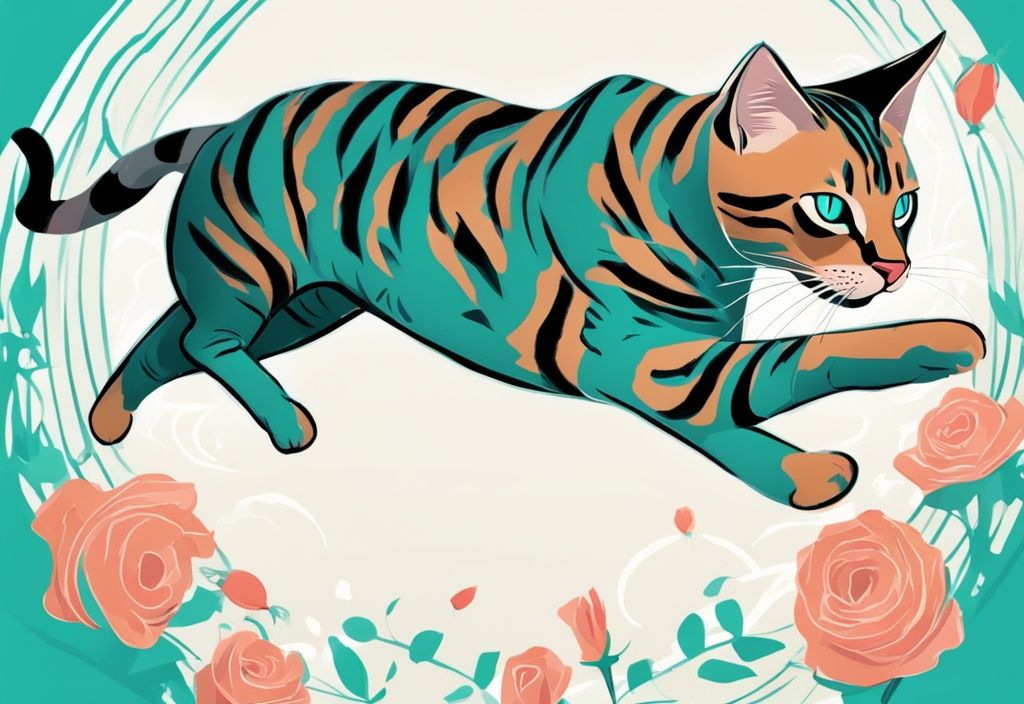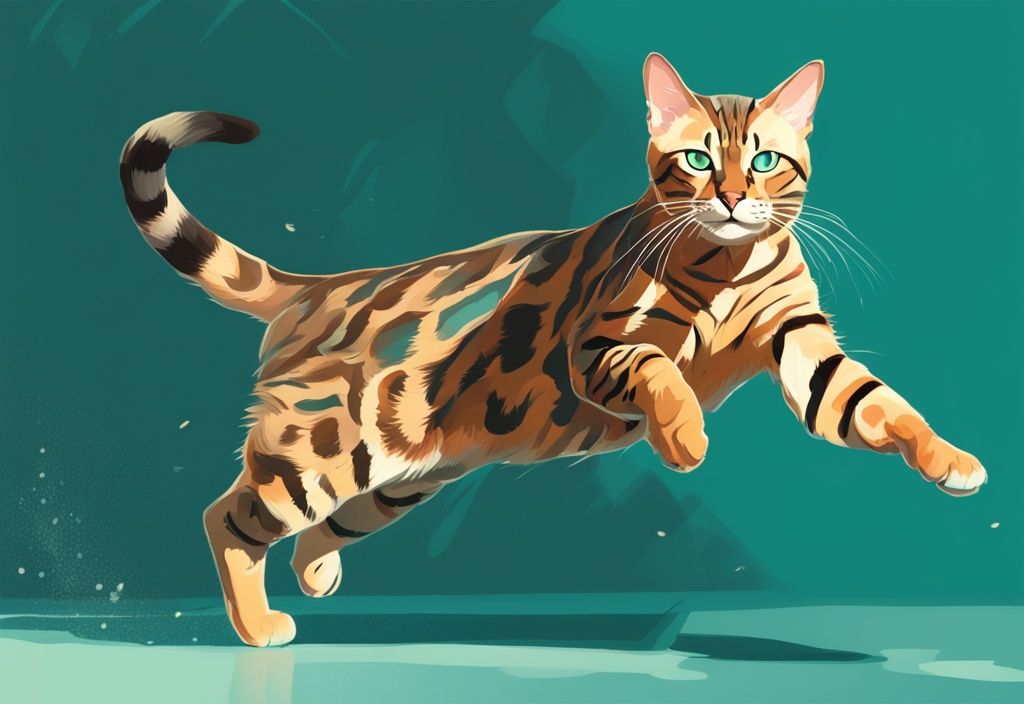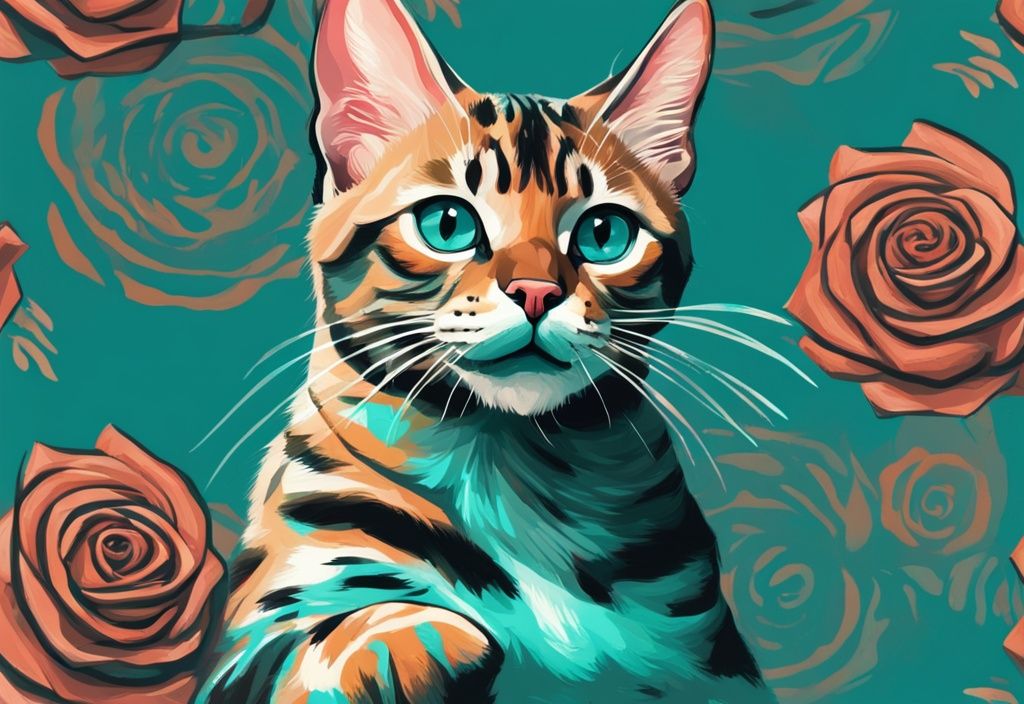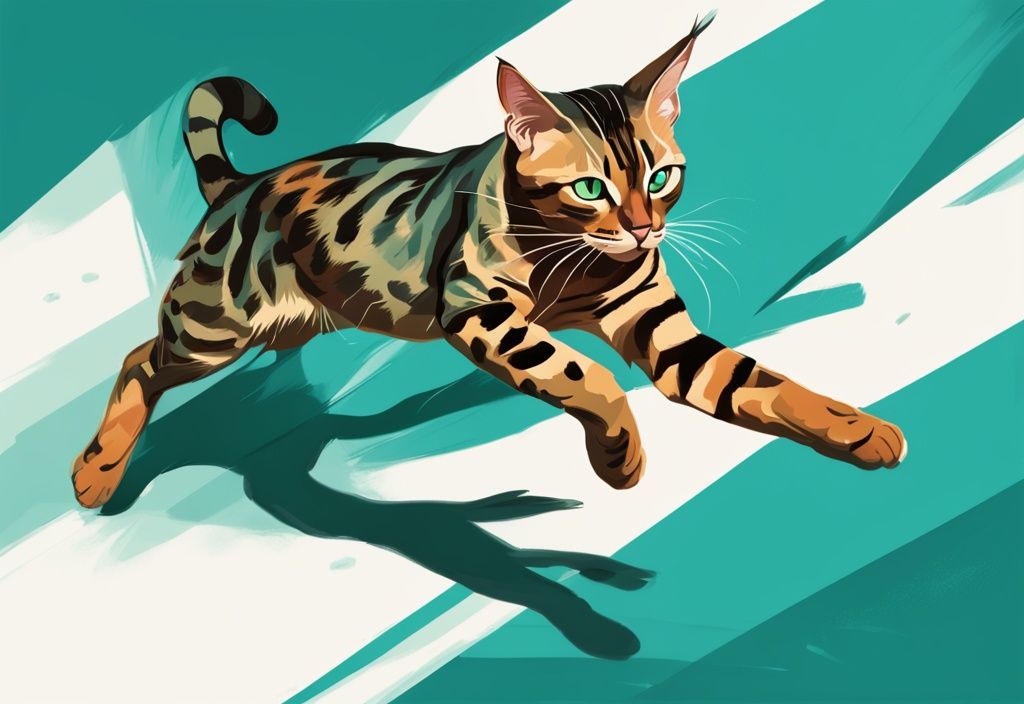Picture this: a pint-sized leopard prancing through your living room, its coat a dazzling array of spots. Meet the Bengal cat, a bundle of energy and exotic charm. With their playful antics and striking looks, Bengals are more than just pets—they’re your home’s wild sidekick. As someone who shares a home with my Border Collie, Max, and cuddly cat, Whiskers, I can tell you, these felines add a sprinkle of adventure to everyday life. Ready to dive into the world of Bengals? Let’s explore together!
FAQs: Answering Your Bengal Cat Queries
Considering a Bengal cat? These fascinating felines are a bundle of energy and charm. Let’s dive into some common questions about living with these spirited companions.
Are Bengal Cats Suitable for First-Time Cat Owners?
Oh, the Bengal cat! They’re like the feline equivalent of a high-octane sports car. While they are stunning and full of personality, they might not be the best choice for first-time cat owners. Their boundless energy and need for constant stimulation can be a bit much if you’re not prepared. Think of them as the marathon runners of the cat world. They thrive with experienced owners who can keep up with their active lifestyle.
Do Bengal Cats Get Along with Other Pets?
Bengals are social butterflies! Their curious and affectionate nature often makes them a hit with other pets. I’ve seen Whiskers, my cuddly rescue cat, make friends with our neighbor’s Bengal. Just keep in mind, their energy levels are off the charts, so make sure your other pets are ready for a playful companion.
How Much Exercise Does a Bengal Cat Need?
Exercise is the name of the game for Bengals. Imagine a tiny, furry athlete who’s always ready for action. They need plenty of interactive play and love having vertical spaces to climb. It’s like having a mini jungle gym in your living room! Keeping them engaged is key to their happiness.
Are Bengal Cats Hypoallergenic?
Ah, the myth of the hypoallergenic Bengal! While they might seem like the perfect solution for allergy sufferers, they can still trigger allergies in sensitive individuals. So, if you’re prone to sneezing fits, you might want to spend some time with a Bengal before bringing one home.

What is the Average Cost of Owning a Bengal Cat?
Owning a Bengal is a bit like having a luxury pet. From the initial purchase or adoption fees to regular vet visits, high-quality food, and plenty of enrichment toys, these costs add up. But trust me, creating a stimulating environment for your Bengal is worth every penny. After all, a happy Bengal means a happy home!
Understanding the Unique Bengal Cat Breed
Origin and History of the Bengal Cat
The Bengal cat is a fascinating hybrid breed, a delightful mix between the wild Asian leopard cat and domestic cats like the spotted Egyptian Mau. Picture this: it’s the 1960s in the United States, and Jean Mill from California is about to change the feline world forever. She played a crucial role in crafting the modern Bengal, a breed that gets its exotic name from the leopard cat’s scientific moniker, Prionailurus bengalensis. By 1986, the International Cat Association (TICA) recognized Bengals as a “new breed,” and by 1991, they were strutting their stuff in championship circles. The Governing Council of the Cat Fancy (GCCF) and the Fédération Internationale Féline (FIFe) soon followed suit, cementing the Bengal’s spot in the feline hall of fame.
Physical Characteristics: From Coat Patterns to Facial Features
Bengal cats are like walking works of art, with coats that could make a leopard do a double-take. Their patterns are a mesmerizing tapestry of spots, rosettes, arrowhead markings, and marbling. TICA recognizes a rainbow of colors, including brown spotted, seal lynx point (snow), sepia, silver, and mink spotted tabby. These cats are not just about looks, though. Their sleek, muscular build and solid boning give them a robust yet elegant presence. Males tend to be a bit larger, but both genders share that wild allure. Just look at their broad, wedge-shaped heads, high cheekbones, and those large, expressive eyes that seem to say, “Let’s play!”
And let’s not forget the long-haired Bengals, known as Cashmere Bengals. Their semi-long haired coats add an extra layer of charm, making them the feline equivalent of a plush toy.
Behavior and Temperament: What to Expect
Bengal cats are the life of the party, always ready for action. Their high energy and playful nature mean they need plenty of mental and physical stimulation. Puzzle toys? Check. Interactive games? Absolutely. And don’t be surprised if they decide to join you in the shower—they have an unusual love for water! Bengals are generally sociable and get along well with other pets, though their energy levels can sometimes be a bit much for the more laid-back members of the household.
These cats are vocal, too, using a symphony of sounds to communicate. Some even describe them as dog-like, thanks to their attachment to their owners. While they might not be lap cats, they love being involved in whatever you’re doing, making them engaging companions. So, if you’re looking for a cat that keeps you on your toes and fills your home with joy, the Bengal might just be your perfect match.

Essential Care Guidelines for Bengal Cats
Health and Lifespan: Common Concerns and Expectations
Bengal cats are like little furry dynamos, often sticking around for 12 to 16 years. That’s a whole lot of purrs and playful antics! While Bengals are generally healthy, they do have a few genetic quirks to watch out for, like progressive retinal atrophy, a hereditary form of retinal degeneration that has been studied in Bengal cats, and hypertrophic cardiomyopathy (HCM). For more information on this condition, you can read about it in detail in the research article here. Now, HCM is a bit of a sneaky one—there’s no magic test for it yet (as of 2018), so regular check-ups are a must, especially for breeding cats. Breeders often do genetic testing to keep future Bengals healthy, but spotting HCM requires an echocardiogram. If you’re passionate about animal welfare, you might also be interested in learning more about National Rescue Dog Day, which focuses on the importance of adopting pets in need. It’s all about keeping that Bengal gene pool strong and vibrant!
Diet and Nutrition: Feeding Your Bengal Cat
Feeding a Bengal cat is a bit like catering to a tiny, furry carnivore with a gourmet palate. These cats are obligate carnivores, meaning they need a diet rich in protein. Think of it as serving up a meal that would make their wild ancestors proud! High-quality, protein-packed food is the key to supporting their energetic lifestyle and maintaining those sleek, muscular physiques. And don’t forget the playtime! Engaging them in games that mimic hunting not only satisfies their dietary needs but also keeps their instincts sharp and their spirits high.
Grooming and Exercise: Keeping Your Bengal Cat Happy
Bengals are the low-maintenance divas of the cat world when it comes to grooming. Their coats are easy to care for, but they do love the social bonding that comes with a good brushing session. These cats are like little acrobats, thriving in spaces where they can climb and explore. Cat trees? Yes, please! Their intelligence and curiosity make them perfect candidates for leash training, opening up a world of safe outdoor adventures.
To keep your Bengal mentally and physically fit, think high-level enrichment. Interactive play and simulated hunting games are fantastic for burning off that endless energy. With their zest for life and inquisitive nature, Bengals are best suited for experienced owners who can provide a stimulating environment. It’s all about creating a world where your Bengal can thrive and be their delightful, mischievous selves!
Legal Considerations for Bengal Cat Ownership
Owning a Bengal cat is like inviting a little piece of the wild into your living room—exciting, but not without its legal hoops to jump through. Let’s dive into what you need to know to keep everything above board.
Ownership Restrictions: Where Are Bengal Cats Allowed?
Imagine bringing home a Bengal cat, only to find out it’s a no-go in your area. Yikes! Some places like Hawaii, Connecticut, Alaska, and New York City have rules that either limit or flat-out prohibit Bengal cat ownership. Why, you ask? Well, it’s all about their wild ancestry and the potential mischief they might get up to in a domestic setting. So, before you fall in love with those striking spots and playful antics, do your homework. Check your local regulations to make sure you’re in the clear and can enjoy your new feline friend without any legal hiccups.
Understanding the Legal Implications of Owning a Bengal Cat
Thinking about adding a Bengal cat to your family? Let’s chat about the legal stuff. Bengals have to stick to strict breeding standards—no outcross breeds allowed in their family tree. This keeps their unique traits intact and helps avoid any behavioral surprises. But here’s the kicker: laws can vary a ton depending on where you live. So, grab a cup of tea, snuggle up with your current fur babies, and dig into your local laws. This little bit of research ensures you can legally and joyfully welcome a Bengal cat into your life, without any unexpected legal drama.

FAQs: Answering Your Bengal Cat Queries
Ever wondered if a Bengal cat is the right fit for your home? Let’s dive into some common questions to help you decide!
Are Bengal Cats Suitable for First-Time Cat Owners?
Imagine a whirlwind of energy wrapped in a beautiful, spotted coat—that’s a Bengal cat for you! While they’re stunning, their high-energy antics might be a bit much for first-time cat owners. Think of them like a feline version of a toddler on a sugar rush! They need lots of playtime and mental challenges to keep them happy. If you’re new to cats, you might find their lively nature a tad overwhelming, but with the right environment, they can thrive.
Do Bengal Cats Get Along with Other Pets?
Bengals are social butterflies! With their curious and affectionate demeanor, they usually get along well with other pets. Picture a Bengal cat as that friendly neighbor who wants to be part of every backyard BBQ. They love being part of a family, whether it includes kids, dogs, or other cats. Just make sure their energetic behavior has an outlet, and you’ll have a harmonious household.
How Much Exercise Does a Bengal Cat Need?
Bengals are like little athletes in fur coats. They need plenty of exercise and mental stimulation to stay happy. Think of interactive play sessions, puzzle toys, and vertical spaces for climbing as their personal gym. Keeping them engaged is key to their well-being, much like how my Border Collie, Max, needs his daily runs!
Are Bengal Cats Hypoallergenic?
Here’s a little myth-buster: Bengal cats aren’t hypoallergenic. Despite their sleek appearance, they can still trigger allergies in sensitive folks due to their dander and saliva. So, if you’re prone to sneezes, you might want to spend some time with a Bengal before bringing one home.
What is the Average Cost of Owning a Bengal Cat?
Owning a Bengal cat is a bit like having a VIP guest at home. You’ll need to budget for initial costs like adoption fees, regular vet check-ups, quality food, and plenty of enrichment toys. These expenses ensure your Bengal is not just surviving but thriving, much like how Whiskers, my cuddly rescue cat, thrives with her favorite feather toys!
Conclusion: Is a Bengal Cat Right for You?
Deciding if a Bengal cat is the perfect addition to your home is like choosing the right dance partner—it’s all about rhythm and energy! Bengals are not your average couch-potato cats; they’re more like the feline version of my Border Collie, Max—always on the go and ready for the next adventure. If your schedule is packed tighter than a can of sardines, a Bengal might not be your best bet. But if you have the time and energy to match their zest for life, you’re in for a delightful ride.
Bengals thrive in environments that are as stimulating as a catnip-filled playground. They love interactive play, climbing, and exploring every nook and cranny. Imagine them as little furry explorers, always on the hunt for new challenges. Providing them with a variety of toys, vertical spaces, and exercise opportunities will keep their curious minds and agile bodies happy.
These cats are a dream for seasoned cat owners who relish the hustle and bustle of a high-energy pet. Bengals might not be the best choice for first-time cat parents, as their care needs a bit more finesse—kind of like trying to keep up with my rescue cat, Whiskers, when she’s in one of her playful moods. But if you’re ready to embrace the lively and affectionate nature of a Bengal, you’ll find them to be a delightful addition to your family, bringing joy and entertainment to your home.
